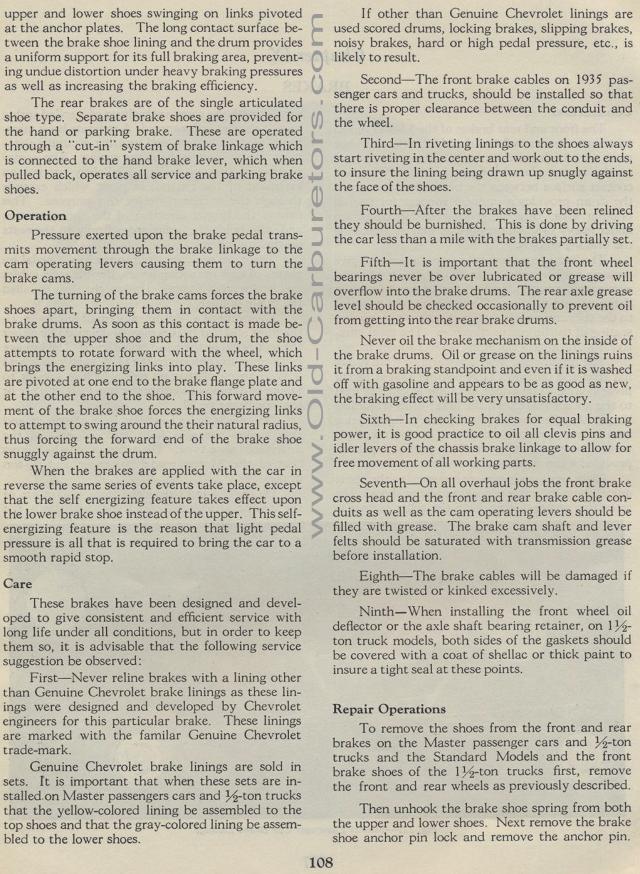Skip to: site menu | section menu | main content
upper and lower shoes swinging on links pivoted at the anchor plates. The long contact surface between the brake shoe lining and the drum provides a uniform support for its full braking area, preventing undue distortion under heavy braking pressures as well as increasing the braking efficiency.
The rear brakes are of the single articulated shoe type. Separate brake shoes are provided for the hand or parking brake. These are operated through a "cut-in" system of brake linkage which is connected to the hand brake lever, which when pulled back, operates all service and parking brake shoes.
Operation
Pressure exerted upon the brake pedal transmits movement through
the brake linkage to the cam operating levers causing them to
turn the brake cams.
The turning of the brake cams forces the brake shoes apart, bringing
them in contact with the brake drums. As soon as this contact is
made between the upper shoe and the drum, the shoe attempts to
rotate forward with the wheel, which brings the energizing links
into play. These links are pivoted at one end to the brake flange
plate and at the other end to the shoe. This forward movement of
the brake shoe forces the energizing links to attempt to swing
around the their natural radius, thus forcing the forward end of
the brake shoe snuggly against the drum.
When the brakes are applied with the car in reverse the same series
of events take place, except that the self energizing feature takes
effect upon the lower brake shoe instead of the upper. This self-energizing
feature is the reason that light pedal pressure is all that is
required to bring the car to a smooth rapid stop.
Care
These brakes have been designed and developed to give consistent
and efficient service with long life under all conditions, but
in order to keep them so, it is advisable that the following
service suggestion be observed:
First— Never reline brakes with a lining other than Genuine
Chevrolet brake linings as these linings were designed and developed
by Chevrolet engineers for this particular brake. These linings
are marked with the familar Genuine Chevrolet trade-mark.
Genuine Chevrolet brake linings are sold in sets. It is important
that when these sets are in-stalled on Master passengers cars and
%-ton trucks that the yellow-colored lining be assembled to the
top shoes and that the gray-colored lining be assembled to the
lower shoes.
If other than Genuine Chevrolet linings are used scored drums,
locking brakes, slipping brakes, noisy brakes, hard or high pedal
pressure, etc., is likely to result.
Second— The front brake cables on 1935
passenger cars and trucks, should be installed so that there is proper clearance between
the conduit and the wheel.
Third— In riveting linings to the shoes always start riveting
in the center and work out to the ends, to insure the lining being
drawn up snugly against the face of the shoes.
Fourth— After the brakes have been relined they should be
burnished. This is done by driving the car less than a mile with
the brakes partially set.
Fifth— It is important that the front wheel bearings never
be over lubricated or grease will overflow into the brake drums.
The rear axle grease level should be checked occasionally to prevent
oil from getting into the rear brake drums.
Never oil the brake mechanism on the inside of the brake drums.
Oil or grease on the linings ruins it from a braking standpoint
and even if it is washed off with gasoline and appears to be as
good as new, the braking effect will be very unsatisfactory.
Sixth— In checking brakes for equal braking power, it is
good practice to oil all clevis pins and idler levers of the chassis
brake linkage to allow for free movement of all working parts.
Seventh— On all overhaul jobs the front brake cross head
and the front and rear brake cable conduits as well as the cam
operating levers should be filled with grease. The brake cam shaft
and lever felts should be saturated with transmission grease before
installation.
Eighth— The brake cables will be damaged if they are twisted
or kinked excessively.
Ninth— When installing the front wheel oil deflector or the
axle shaft bearing retainer, on 11A-ton truck models, both sides
of the gaskets should be covered with a coat of shellac or thick
paint to insure a tight seal at these points.
Repair Operations
To remove the shoes from the front and rear brakes on the Master
passenger cars and %-ton trucks and the Standard Models and the
front brake shoes of the 1½-ton trucks first, remove the
front and rear wheels as previously described.
Then unhook the brake shoe spring from both the upper and lower
shoes. Next remove the brake shoe anchor pin lock and remove the
anchor pin.
